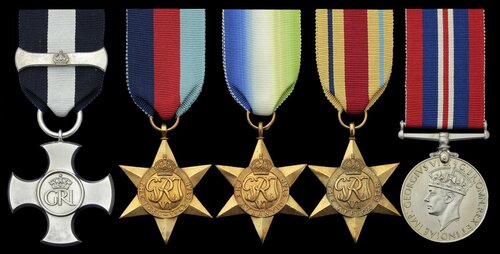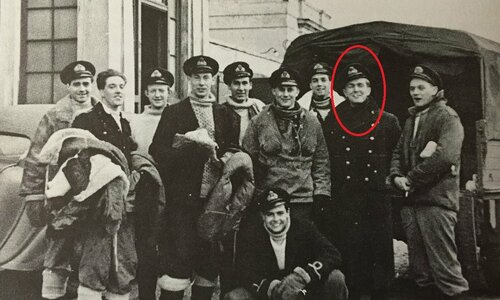Auction: 21002 - Orders, Decorations and Medals
Lot: 205
A rare Second World War Coastal Forces D.S.C. and Bar group of five attributed to Lieutenant J. A. Wolfe, Royal Naval Volunteer Reserve, a gallant skipper of the famous 21st M.T.B. Flotilla
Described by his Senior Officer as being 'cool, courageous and the best dressed Officer at sea in short M.T.B.s', Wolfe undoubtedly made his mark as C.O. of M.T.B. 232 in a string of close encounters of the hair-raising kind in 1944
Distinguished Service Cross, the reverse officially dated '1944' and privately inscribed 'Lt. J. A. Wolfe M.T.B. 232', with Second Award Bar, officially dated '1945'; 1939-45 Star; Atlantic Star; Africa Star; War Medal 1939-45, good very fine (5)
D.S.C. London Gazette 1 August 1944. The original recommendation states:
'As Commanding Officer of a 21st M.T.B. Flotilla boat, he has taken part in 40 successful minelaying operations in close proximity to the enemy coast, in addition to having been in action in torpedo attacks on enemy convoys on four occasions in the Nore Command. His resoluteness and calm courage have in no small measure material assistance in controlling the large formations of Boats taking part in the operations and completing them successfully. He has set a fine example to his fellow officers by his keenness, courage and devotion to duty.
During the past year he has participated in several actions against the enemy as Commanding Officer of M.T.B. 232 and has always conducted himself in the highest traditions of the service. He has been extremely unfortunate in not achieving more material success, especially in his last action against an enemy convoy off Terschelling in March last, when he pressed home a torpedo attack to close range in adverse conditions, only to be frustrated of a certain hit by both torpedoes misfiring.'
Bar to D.S.C. London Gazette 2 January 1945. The original recommendation for the action off the Dutch Coast on 14/15 September 1944 states:
'Lieutenant Wolfe as a divisional leader to Lieutenant MacDonald led the 2nd Division from seaward to the attack against this very heavily escorted convoy. Under heavy enemy fire he pressed forward his attack through the escort against the larger of two merchant vessels illuminated by the rocket flares he had called for from the 1st Division under Lieutenant MacDonald.
This zone attack, resulted in two torpedo hits and the destruction of the target.
Lieutenant Wolfe has taken part in many successful actions in Lieutenant MacDonald's Flotilla. Cool, courageous and the best dressed Officer at sea in short M.T.B.'s.'
John Alfred Wolfe was commissioned Probationary Sub. Lieutenant in the Royal Naval Volunteer Reserve (R.N.V.R.) in February 1940 and joined Coastal Forces that summer, when he assumed command of M.T.B. 107 at Felixstowe. Having then served at Mosquito, the Coastal Force base at Alexandria, he returned to the U.K. to take command of M.T.B. 232 in September 1943. Here, then, the commencement of his operational career in the famous 21st M.T.B. Flotilla, commanded by Lieutenant G. J. 'Mac' Macdonald, D.S.O., D.S.C. and 2 Bars, Royal New Zealand Volunteer Reserve.
Wolfe's opening action - the first fought by the 21st Flotilla under MacDonald's command - took place off Ymuiden on 6 March 1944: it proved to be a successful encounter with enemy armed trawlers and is referred to in the recommendation for his D.S.C.
Between then and his leaving 232 for pastures new in early 1944, Wolfe was to witness many more memorable clashes of a Costal Forces nature, winning a brace of D.S.C.s over a five-month period.
One of these subsequent actions is best summarised by Home Waters MTBs and MGBs at War 1939-45, by Leonard Reynolds:
'News came through of a particularly fine action off Terschelling involving the 21st Flotilla, now led by Lt. G. J. MacDonald, at twenty-one the youngest flotilla leader S.O. ever appointed. He had been tireless in his patrolling but targets since the invasion had dried up. On the night of 4-5 July [1944] he took out a five-boat unit, with 234 now back in the lead, followed by 224, 225, 232 [Wolfe] and 244. They found a convoy by radar, tracked it and then attacked. The strong escort fought them off, and the convoy was led into the safe harbour at West Gat. MacDonald split his force into two divisions and continued to search, and his group met a second convoy upon which they made a zone attack with a spread of torpedoes at 1,000 yards. One coaster was hit and left in flames. The second division then attacked individually from inshore and claimed a hit on one of the escorts at 1.800 yards.
MacDonald thought that these two could be regarded as sunk, and this was confirmed by air reconnaissance. Surprisingly, enemy radio admitted that in fact two vessels had been sunk. MacDonald was awarded a D.S.O. to add to the D.S.C. and two Bars already won during the previous two years of constant patrolling and action.'
The 21st Flotilla was back in action off Scheveningen on the night of the 20-21 July:
'MacDonald in 234, with 224 (A.J. Lee), formed Division 1 and 225 (Gill) and 232 (Wolfe) were Division 2. A patrol of trawlers was detected and attacked, using the classic method of approaching from opposite sides with coordinated timing of zone attacks. The second division was first to record a hit, while the first group had to make a second approach but they believed they too had secured a hit, judging by the concussion felt by all of the boats. CCR pistols were once again a boon: throughout Coastal Forces there was an air of disbelief that a weapon which brought such an immediate increase in the success rate of torpedo firing should have been so long in arriving because of development problems' (ibid).
As cited above, Wolfe was awarded a Bar to his D.S.C. for an action off the Dutch coast on the night of 14-15 September 1944:
'On 14-15 September [1944], MacDonald in 234 led seven boats to patrol Terschilling: five of his own flotilla (234, 233, 232 [Wolfe], 223 and 244), and two of the 22nd (83 and 88). As meticulous as ever in his observation and judgement, he embarked on a lengthy stalk of a convoy to establish its size, course and speed, and then decided to take the first division to the inshore side to make the opening attack. This led to early detection and a fierce response from the heavy escort, causing him to move away temporarily. But as he had hoped, the second division, led by John Wolfe in 232, had not been sighted and were able to make a zone attack from seaward, securing two hits on a 2,000-ton merchant vessel at 1,500 yards. As ever, MacDonald was not content to leave it at that, and he made a second attack from inshore. The spread of torpedoes from his boats was skilfully avoided by the trawlers of the escort, and no hits were obtained. It had been a copybook action involving careful plotting, a two-sided attack and zone firing - all regarded as best practice at the time, and it deserved more success' (ibid).
Wolfe's second D.S.C. may also have been attributable to his final action as C.O. of 232:
'On the same night [8-9 October 1944] further north, off Texel, MacDonald took a patrol from the 21st and 22nd Flotillas, very similar in composition to the group which had sunk a merchant ship in September off Terschilling. They were equally successful, with an M Class minesweeper being sunk in a zone attack by the second division, consisting of 83 and 88 of the 22nd Flotilla. Jack Coombs of 83 and his Coxswain P.O. L. W. Pratt were both decorated, as were John Wolfe and the Coxswain of 232' (ibid).
Wolfe, who ended the war in command of M.T.B. 387, received his D.S.C. at a Buckingham Palace investiture on 7 November 1944 and was likewise presented with his Bar on 10 July 1945.
Subject to 20% VAT on Buyer’s Premium. For more information please view Terms and Conditions for Buyers.
Sold for
£2,400
Starting price
£1000







